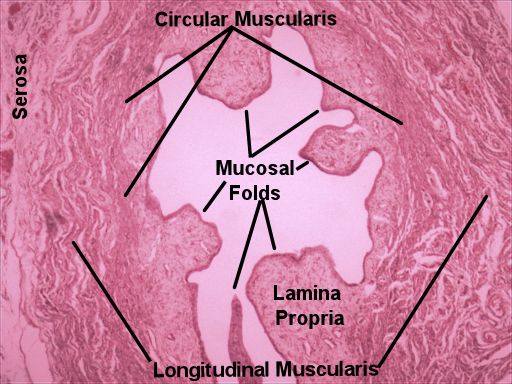
The uterine tube (aka oviduct or Fallopian tube) transports the ova (oocyte) from the ovary to the uterus. There mucosa is made up of ciliated columnar epithelial tissue interspersed with non-ciliated secretory cells. The cilia help move the oocyte to the uterus and are activated upon ovulation. The secretory cells produce nutrients for the oocyte. There is also evidence that their secretions help to activate the sperm. In addition to the lack of cilia, the secretory cells' nuclei stain darker. There are numerous mucosal folds which decrease the volume of the lumen. The epithelial cells are anchored by a lamina propria. This differs from a submucosa layer in that it is made up of loose connective tissue whereas a submucosal layer is made up of dense irregular connective tissue. Similar to the other histological slides we have seen for the past 3 or 4 labs, there is a muscularis layer which has a circular inner layer and a longitudinal outer layer. These layers are thought to provide peristaltic contractions to aid in propelling the oocyte to the uterus. There are in also 2 serosa layers. The true serosa encloses the uterine tube and forms the visceral membrane. The sub-serosa contains numerous blood vessels. These pictures were taken by me in the spring of 2021. They progress from scanning power (40x) to high power (400x). Go through the pictures. Select one, draw it, and label the layers.
| Labeled Image | Unlabeled Images |
|---|---|
 |
|